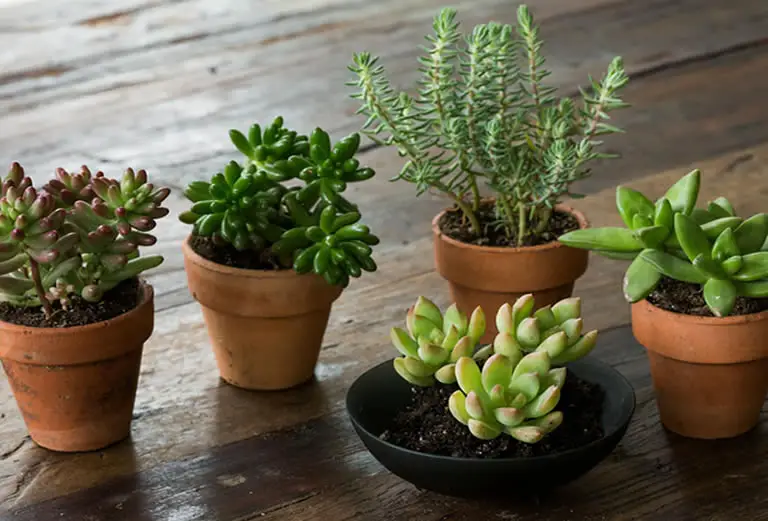If you’ve been craving a low-maintenance, high-impact plant that can thrive just about anywhere, Sedum might be your new best friend. With their chubby leaves, trailing or upright habits, and ability to thrive in some seriously tough conditions, these hardy succulents are basically the overachievers of the plant world.
Also known as stonecrops, Sedums come in hundreds of varieties—some are dainty and delicate, others grow into thick mats of vibrant foliage perfect for ground cover. Whether you’re growing them in pots, rock gardens, window boxes, or even between stepping stones, Sedum is a champion of easy-care gardening.
Table of Contents
- Where Sedum Comes From: Built for the Extremes
- Popular Sedum Varieties You’ll Want to Grow
- Light Requirements: Sunshine Is the Secret
- Soil: Keep It Gritty and Fast-Draining
- Watering Sedum: Lean and Mean
- Fertilizing Sedum
- How to Grow Sedum Outdoors: A Landscape Superstar
- Propagating Sedum: So Easy, It Feels Like Cheating
- Common Issues and Troubleshooting
- Is Sedum Pet-Safe?
Where Sedum Comes From: Built for the Extremes
Sedums are native to the Northern Hemisphere and are found in rocky, mountainous regions, deserts, and other areas with poor soil and minimal rainfall.
That rugged background is what makes them so adaptable and tough in our gardens and homes.
Most varieties belong to one of two main categories:
- Creeping (low-growing): Great for ground cover or trailing from containers.
- Upright (clumping): Taller, bushier types that produce lovely blooms and structure.
Popular Sedum Varieties You’ll Want to Grow
There’s a Sedum for every style—whether you’re into cute trailing stems or colorful ground-huggers.
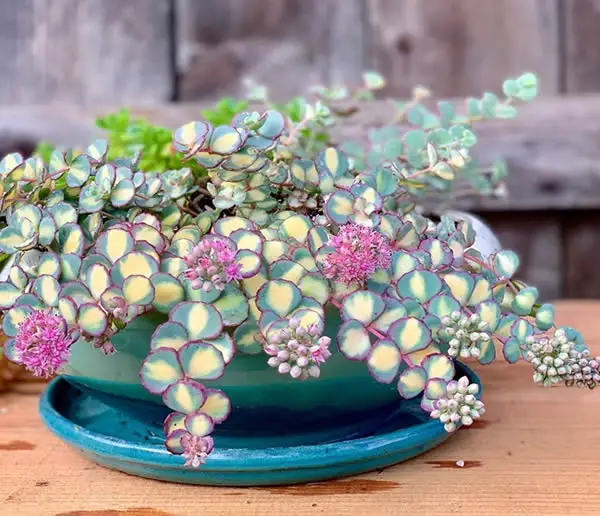
Here’s a lineup of the most beloved varieties (including a few from your list):
- Sedum matrona: A gorgeous upright variety with pink stems and soft green-purple leaves. It blooms in late summer with rosy-pink flowers—super showy and pollinator-friendly!
- Sedum burrito (Burro’s Tail): Known for its long, trailing stems packed with blue-green jellybean-like leaves. Looks amazing spilling from a hanging pot.
- Sedum morganianum: Often confused with Sedum burrito, this one has longer, slightly more pointed leaves and a similar trailing habit.
- Sedum golden moss (Sedum acre): A bright, chartreuse-green carpet-forming type. It spreads fast and adds a pop of color to rock gardens or between stepping stones.
- Sedum treleasei: A lesser-known gem with plump, powdery blue-green leaves and pink-tinged tips. Perfect for sunny containers.
- Sedum adolphii (Golden Sedum): This beauty turns a lovely golden-orange color in full sun. It’s fast-growing and produces creamy white blooms.
- Lemon ball sedum: A bright, citrusy green sedum with a super textural, fluffy appearance. It spreads quickly and looks stunning in mass plantings.
- Lemon coral sedum: Similar to lemon ball but even more lime-colored and slightly softer in shape. Great in planters or cascading over retaining walls.
- Stone step sedum (Sedum spurium): A low, creeping type ideal for pathways. It tolerates some foot traffic and forms thick mats with pink or red accents.
- Sedum angelina: Chartreuse, needle-like foliage that turns orange in cooler temps. Very cold-hardy and fast to fill in.
- Sedum autumn (Autumn Joy): An upright garden favorite with succulent gray-green leaves and large clusters of dusty pink flowers that age to copper—gorgeous in fall!
- Sedum imbricatum (commonly lumped with matron in lists): A charming, fleshy-leaved sedum with a tidy growth habit and white summer blooms.
Note: Some of these names (like burrito and morganianum) are often used interchangeably by nurseries—but slight differences in leaf shape and growth patterns make them fun to distinguish once you get familiar.
Light Requirements: Sunshine Is the Secret
Sedums are serious sun-seekers.
Indoors, they need at least 6 hours of bright, direct sunlight a day—more if you can give it.
Outdoors, full sun will bring out the brightest colors and most compact shapes.
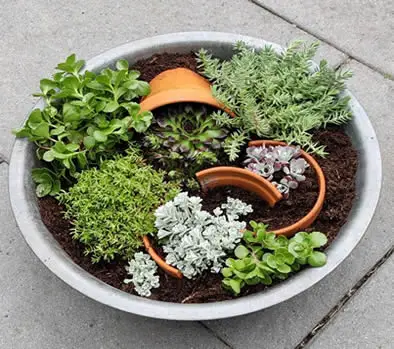
If you’re growing Sedum inside and notice stretching or fading colors, that’s a sign it needs more light.
A south-facing window or grow light setup can work wonders.
Soil: Keep It Gritty and Fast-Draining
Sedums hate sitting in wet soil. Plant them in a cactus or succulent mix, or make your own blend using:
- 2 parts regular potting soil
- 1 part coarse sand or perlite
- 1 part pumice or crushed gravel
Outdoors, avoid planting in clay-heavy areas unless you amend with lots of sand or plant them in raised beds.
Watering Sedum: Lean and Mean
Sedums store water in their leaves and prefer to dry out completely between waterings.
Indoors, water when the soil feels bone dry—usually every 2–3 weeks depending on light and temperature.
Outdoors, they’re often fine with natural rainfall (unless you’re in a drought).
Overwatering is the #1 way to kill a Sedum—when in doubt, wait another few days.
Fertilizing Sedum
These aren’t hungry plants.
A light feeding once in spring with a diluted succulent fertilizer is more than enough.
I find that a good cacti feed, like this one, works exceptionally well with Sedum succulents.
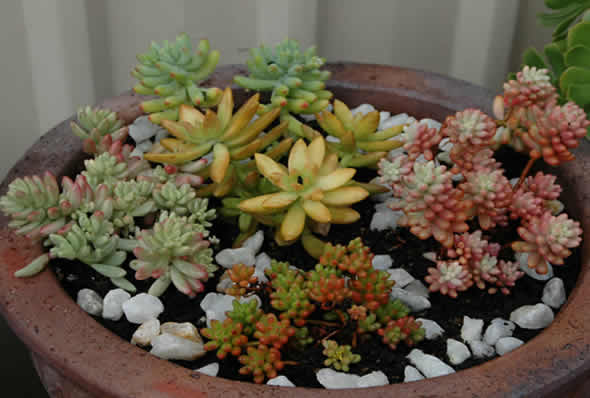
Over-fertilizing can actually cause leggy, floppy growth—so keep it minimal.
How to Grow Sedum Outdoors: A Landscape Superstar
Sedum really shines outside. Whether you want low ground cover or upright floral drama, here’s how to make your outdoor Sedum thrive:
- Pick the right spot: Full sun is best for color, shape, and flowering. Some shade-tolerant types exist, but most prefer direct light.
- Mind the drainage: Sedums do not like wet feet. For in-ground planting, work in gravel or sand to loosen heavy soils.
- Spacing: Creeping varieties will spread—so leave space. Upright ones benefit from airflow to avoid rot.
- Winter care: Most Sedums are hardy down to USDA zone 4–5, especially the upright types. They die back in winter and come roaring back in spring. Creeping types like angelina and spurium often stay evergreen.
- Containers: Great on patios or balconies. Terra cotta pots are ideal since they dry out faster. Just protect from deep freezes or bring them inside during winter.
Bonus Tip: Sedums are deer-resistant, drought-tolerant, and pollinator magnets. Once established, they’re basically hands-off.
Propagating Sedum: So Easy, It Feels Like Cheating
Sedums are ridiculously easy to propagate.
Just snip a leaf or stem segment, let it callous for a day or two, and place it on top of soil.
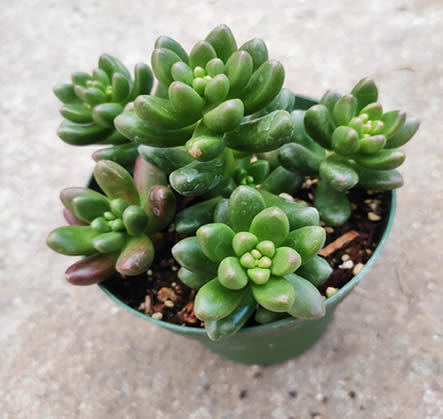
Mist lightly, and roots will appear within a week or two.
Creeping types often root where they touch the soil—so you can divide and replant them easily.
If you want step-by-step instructions be sure to read our guide to propagating sedum.
Common Issues and Troubleshooting
- Mushy leaves: Usually a sign of overwatering or poor drainage. Let the soil dry out and reduce frequency.
- Legginess: Not enough light. Move it to a sunnier spot.
- No blooms: Needs more sun or maturity. Some upright Sedums bloom only once a year.
- Pests: Rare, but mealybugs or aphids can show up—treat with insecticidal soap or neem.
Is Sedum Pet-Safe?
Most Sedum species are considered non-toxic to pets and humans, which makes them a safe pick for homes with curious critters.
However, some can cause mild stomach upset if ingested, so it’s still smart to keep them out of reach.
Sedum’s versatility, charm, and toughness make it a go-to plant for beginners and collectors alike.
Whether you’re tucking them into a rock garden, trailing them from a pot, or brightening up your coffee table, Sedums always bring the glow—with minimal fuss.
Want a printable Sedum cheat sheet or side-by-side variety comparison for your readers? I can whip one up! Just say the word 🌿✨

